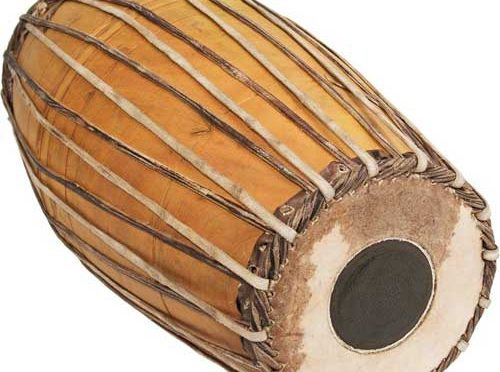The mridangam, a double-headed barrel-shaped drum, is a prominent instrument in Carnatic (South Indian) classical music. It is traditionally played in a seated position with the drum resting on the lap and legs. It serves as the principal rhythmic accompaniment in Carnatic music ensembles, often complemented by instruments like the ghatam, kanjira, and morsing. Its name, “Mridangam,” derives from the Sanskrit words “mŗt” (clay or earth) and “anga” (limb), reflecting its historical construction from hardened clay.
Depicted in ancient Hindu art and mythology, it holds a sacred significance, associated with deities such as Ganesha and Nandi, symbolizing divine rhythm in celestial dances. Evolution through the years led to the use of different woods for durability. Originally confined to accompanying lead performers, particularly vocalists, its role has expanded to include solo performances.
Construction

Constructed from jackfruit or sheesham wood, the mridangam features two membranes covered with goat, cow, or buffalo skin, stretched and laced together with leather straps for resonance.
Distinct pitches are produced from the drum’s two apertures: the larger thoppi or eda bhaaga generates bass tones, while the smaller valanthalai or bala bhaaga produces higher-pitched sounds with a metallic quality, enhanced by a black tuning paste applied to the smaller membrane’s center.
Usage Techniques
Before performances, adjustments to the leather tension and application of paste to the membranes modulate pitch and enhance resonance, with rubber gum now often used for its practicality. Tuning involves striking the tension-bearing straps along the smaller membrane’s circumference, with pitch adjusted by striking towards or away from the hull, ensuring uniform resonance.
Posture
Artists typically play it in a nearly parallel position to the floor, with right-handed performers using their right hand for the smaller membrane and left hand for the larger.
Name Variations: mrdangam, mrudangam, mridanga, miruthangam, or mrdanga.
Notable mridangam players in alphabetical order: Ranganayaki Ammal; A. V. Anand; Akshay Anantapadmanabhan; Muthiah Bhagavatar; Guruvayur Dorai; Mannargudi Easwaran; T. V. Gopalakrishnan; Madras A. Kannan; Anantha Krishnan; Patri Satish Kumar; Umayalpuram Mali; Palghat Mani Iyer; Karaikudi Mani; T. K. Murthy; Erode Nagaraj; Mavelikara Krishnankutty Nair; Mavelikkara Velukkutty Nair; T. S. Nandakumar; Trichur C. Narendran; K. P. Parameswaran; Palani Subramaniam Pillai; K. Arun Prakash; Ramnad Raghavan; Palghat R. Raghu; Kumbakonam M. Rajappa Iyer; Kolanka Venkata Raju; Viveick Rajagopalan; Mavelikkara S. R. Raju; Vellore G. Ramabhadran; H. Ramakrishnan; Thanjavur R. Ramamoorthy; T. Ranganathan; Srimushnam V. Raja Rao; Yella Venkateswara Rao; Trichy Sankaran; Gita Sarabhai; K. S. Bhavani Shankar; Anoor Anantha Krishna Sharma; Umayalpuram K. Sivaraman; Sukanya Ramgopal; Nidumolu Sumathi; Erickavu N. Sunil; Trivandrum V. Surendran; J. Vaidhyanathan; Tiruvarur Vaidyanathan.
Books
Intricacies of Mridangam by T S Nandakumar
A First Course in Mridangam Lessons by Srimushnam V. Raja Rao
Roots of Mridangam by T S Nandakumar


